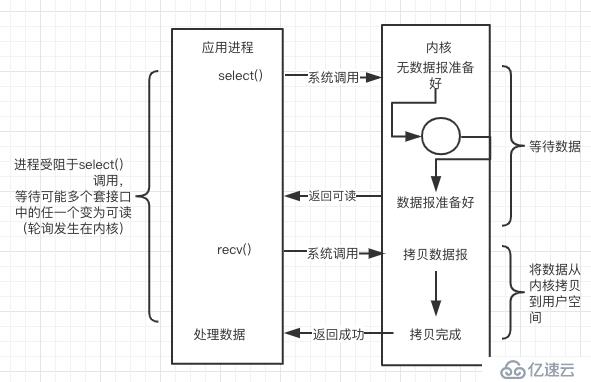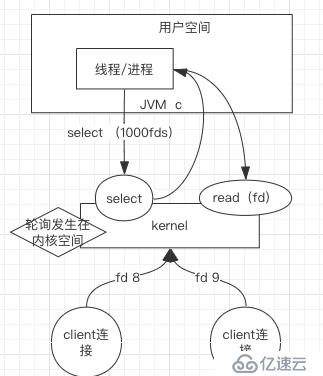жӮЁеҘҪпјҢзҷ»еҪ•еҗҺжүҚиғҪдёӢи®ўеҚ•е“ҰпјҒ
I/OпјҲ INPUT OUTPUTпјүпјҢеҢ…жӢ¬ж–Ү件I/OгҖҒзҪ‘з»ңI/OгҖӮ
и®Ўз®—жңәдё–з•ҢйҮҢзҡ„йҖҹеәҰй„ҷи§Ҷпјҡ
CPU еӨ„зҗҶж•°жҚ®зҡ„йҖҹеәҰиҝңеӨ§дәҺI/OеҮҶеӨҮж•°жҚ®зҡ„йҖҹеәҰ гҖӮ
д»»дҪ•зј–зЁӢиҜӯиЁҖйғҪдјҡйҒҮеҲ°иҝҷз§ҚCPUеӨ„зҗҶйҖҹеәҰе’ҢI/OйҖҹеәҰдёҚеҢ№й…Қзҡ„й—®йўҳ!
еңЁзҪ‘з»ңзј–зЁӢдёӯеҰӮдҪ•иҝӣиЎҢзҪ‘з»ңI/OдјҳеҢ–пјҡжҖҺд№Ҳй«ҳж•Ҳең°еҲ©з”ЁCPUиҝӣиЎҢзҪ‘з»ңж•°жҚ®еӨ„зҗҶпјҹпјҹпјҹ
д»Һж“ҚдҪңзі»з»ҹеұӮйқўжҖҺд№ҲзҗҶи§ЈзҪ‘з»ңI/Oе‘ўпјҹи®Ўз®—жңәзҡ„дё–з•ҢжңүдёҖеҘ—иҮӘе·ұе®ҡд№үзҡ„жҰӮеҝөгҖӮеҰӮжһңдёҚжҳҺзҷҪиҝҷдәӣжҰӮеҝөпјҢе°ұж— жі•зңҹжӯЈжҳҺзҷҪжҠҖжңҜзҡ„и®ҫи®ЎжҖқи·Ҝе’Ңжң¬иҙЁгҖӮжүҖд»ҘеңЁжҲ‘зңӢжқҘпјҢиҝҷдәӣжҰӮеҝөжҳҜдәҶи§ЈжҠҖжңҜе’Ңи®Ўз®—жңәдё–з•Ңзҡ„еҹәзЎҖгҖӮ
зҗҶи§ЈзҪ‘з»ңI/OйҒҝдёҚејҖзҡ„иҜқйўҳпјҡеҗҢжӯҘдёҺејӮжӯҘпјҢйҳ»еЎһдёҺйқһйҳ»еЎһгҖӮ
жӢҝеұұжІ»зғ§ж°ҙдёҫдҫӢжқҘиҜҙпјҢ(еұұжІ»зҡ„иЎҢдёәеҘҪжҜ”з”ЁжҲ·зЁӢеәҸпјҢзғ§ж°ҙеҘҪжҜ”еҶ…ж ёжҸҗдҫӣзҡ„зі»з»ҹи°ғз”Ё)пјҢиҝҷдёӨз»„жҰӮеҝөзҝ»иҜ‘жҲҗеӨ§зҷҪиҜқеҸҜд»Ҙиҝҷд№ҲзҗҶи§ЈгҖӮ
зӮ№зҒ«еҗҺпјҢеӮ»зӯүпјҢдёҚзӯүеҲ°ж°ҙејҖеқҡеҶідёҚе№Ід»»дҪ•дәӢпјҲйҳ»еЎһпјүпјҢж°ҙејҖдәҶе…ізҒ«пјҲеҗҢжӯҘпјүгҖӮ

зӮ№зҒ«еҗҺпјҢеҺ»зңӢз”өи§ҶпјҲйқһйҳ»еЎһпјүпјҢж—¶дёҚж—¶зңӢж°ҙејҖдәҶжІЎжңүпјҢж°ҙејҖеҗҺе…ізҒ«пјҲеҗҢжӯҘпјүгҖӮ

жҢүдёӢејҖе…іеҗҺпјҢеӮ»зӯүж°ҙејҖпјҲйҳ»еЎһпјүпјҢж°ҙејҖеҗҺиҮӘеҠЁж–ӯз”өпјҲејӮжӯҘпјүгҖӮ

зҪ‘з»ңзј–зЁӢдёӯдёҚеӯҳеңЁзҡ„жЁЎеһӢгҖӮ
жҢүдёӢејҖе…іеҗҺпјҢиҜҘе№Іеҳӣе№Іеҳӣ пјҲйқһйҳ»еЎһпјүпјҢж°ҙејҖеҗҺиҮӘеҠЁж–ӯз”өпјҲејӮжӯҘпјүгҖӮ




з”ЁжҲ·жҖҒе’ҢеҶ…ж ёжҖҒзҡ„еҲҮжҚўиҖ—ж—¶пјҢиҙ№иө„жәҗпјҲеҶ…еӯҳгҖҒCPUпјү
дјҳеҢ–е»әи®®пјҡ




зҪ‘з»ңзј–зЁӢйғҪйңҖиҰҒзҹҘйҒ“FDпјҹпјҹпјҹ FDжҳҜдёӘд»Җд№Ҳй¬јпјҹпјҹпјҹ
LinuxпјҡдёҮзү©йғҪжҳҜж–Ү件пјҢFDе°ұжҳҜж–Ү件зҡ„еј•з”ЁгҖӮеғҸдёҚеғҸJAVAдёӯдёҮзү©йғҪжҳҜеҜ№иұЎ?зЁӢеәҸдёӯж“ҚдҪңзҡ„жҳҜеҜ№иұЎзҡ„еј•з”ЁгҖӮJAVAдёӯеҲӣе»әеҜ№иұЎзҡ„дёӘж•°жңүеҶ…еӯҳзҡ„йҷҗеҲ¶пјҢеҗҢж ·FDзҡ„дёӘж•°д№ҹжҳҜжңүйҷҗеҲ¶зҡ„гҖӮ

LinuxеңЁеӨ„зҗҶж–Ү件е’ҢзҪ‘з»ңиҝһжҺҘж—¶пјҢйғҪйңҖиҰҒжү“ејҖе’Ңе…ій—ӯFDгҖӮ
жҜҸдёӘиҝӣзЁӢйғҪдјҡжңүй»ҳи®Өзҡ„FDпјҡ

жҖҺд№ҲдјҳеҢ–е‘ўпјҹ
еҜ№дәҺдёҖж¬ЎI/Oи®ҝй—®пјҲд»ҘreadдёҫдҫӢпјүпјҢж•°жҚ®дјҡе…Ҳиў«жӢ·иҙқеҲ°ж“ҚдҪңзі»з»ҹеҶ…ж ёзҡ„зј“еҶІеҢәпјҢ然еҗҺжүҚдјҡд»Һж“ҚдҪңзі»з»ҹеҶ…ж ёзҡ„зј“еҶІеҢәжӢ·иҙқеҲ°еә”з”ЁзЁӢеәҸзҡ„ең°еқҖз©әй—ҙгҖӮ
жүҖд»ҘиҜҙпјҢеҪ“дёҖдёӘreadж“ҚдҪңеҸ‘з”ҹж—¶пјҢе®ғдјҡз»ҸеҺҶдёӨдёӘйҳ¶ж®өпјҡ
жӯЈжҳҜеӣ дёәиҝҷдёӨдёӘйҳ¶ж®өпјҢLinuxзі»з»ҹеҚҮзә§иҝӯд»ЈдёӯеҮәзҺ°дәҶдёӢйқўдёүз§ҚзҪ‘з»ңжЁЎејҸзҡ„и§ЈеҶіж–№жЎҲгҖӮ

з®Җд»ӢпјҡжңҖеҺҹе§Ӣзҡ„зҪ‘з»ңI/OжЁЎеһӢгҖӮиҝӣзЁӢдјҡдёҖзӣҙйҳ»еЎһпјҢзӣҙеҲ°ж•°жҚ®жӢ·иҙқе®ҢжҲҗгҖӮ
зјәзӮ№пјҡй«ҳ并еҸ‘ж—¶пјҢжңҚеҠЎз«ҜдёҺе®ўжҲ·з«ҜеҜ№зӯүиҝһжҺҘпјҢзәҝзЁӢеӨҡеёҰжқҘзҡ„й—®йўҳпјҡ
public static void main(String[] args) throws IOException {
ServerSocket ss = new ServerSocket();
ss.bind(new InetSocketAddress(Constant.HOST, Constant.PORT));
int idx =0;
while (true) {
final Socket socket = ss.accept();//йҳ»еЎһж–№жі•
new Thread(() -> {
handle(socket);
},"зәҝзЁӢ["+idx+"]" ).start();
}
}
static void handle(Socket socket) {
byte[] bytes = new byte[1024];
try {
String serverMsg = " server sss[ зәҝзЁӢпјҡ"+ Thread.currentThread().getName() +"]";
socket.getOutputStream().write(serverMsg.getBytes());//йҳ»еЎһж–№жі•
socket.getOutputStream().flush();
} catch (Exception e) {
e.printStackTrace();
}
}
з®Җд»ӢпјҡиҝӣзЁӢеҸҚеӨҚзі»з»ҹи°ғз”ЁпјҢ并马дёҠиҝ”еӣһз»“жһңгҖӮ
зјәзӮ№пјҡеҪ“иҝӣзЁӢжңү1000fds,д»ЈиЎЁз”ЁжҲ·иҝӣзЁӢиҪ®иҜўеҸ‘з”ҹзі»з»ҹи°ғз”Ё1000ж¬ЎkernelпјҢжқҘеӣһзҡ„з”ЁжҲ·жҖҒе’ҢеҶ…ж ёжҖҒзҡ„еҲҮжҚўпјҢжҲҗжң¬еҮ дҪ•дёҠеҚҮгҖӮ
public static void main(String[] args) throws IOException {
ServerSocketChannel ss = ServerSocketChannel.open();
ss.bind(new InetSocketAddress(Constant.HOST, Constant.PORT));
System.out.println(" NIO server started ... ");
ss.configureBlocking(false);
int idx =0;
while (true) {
final SocketChannel socket = ss.accept();//йҳ»еЎһж–№жі•
new Thread(() -> {
handle(socket);
},"зәҝзЁӢ["+idx+"]" ).start();
}
}
static void handle(SocketChannel socket) {
try {
socket.configureBlocking(false);
ByteBuffer byteBuffer = ByteBuffer.allocate(1024);
socket.read(byteBuffer);
byteBuffer.flip();
System.out.println("иҜ·жұӮпјҡ" + new String(byteBuffer.array()));
String resp = "жңҚеҠЎеҷЁе“Қеә”";
byteBuffer.get(resp.getBytes());
socket.write(byteBuffer);
} catch (IOException e) {
e.printStackTrace();
}
}
з®Җд»ӢпјҡеҚ•дёӘзәҝзЁӢе°ұеҸҜд»ҘеҗҢж—¶еӨ„зҗҶеӨҡдёӘзҪ‘з»ңиҝһжҺҘгҖӮеҶ…ж ёиҙҹиҙЈиҪ®иҜўжүҖжңүsocketпјҢеҪ“жҹҗдёӘsocketжңүж•°жҚ®еҲ°иҫҫдәҶпјҢе°ұйҖҡзҹҘз”ЁжҲ·иҝӣзЁӢгҖӮеӨҡи·ҜеӨҚз”ЁеңЁLinuxеҶ…ж ёд»Јз Ғиҝӯд»ЈиҝҮзЁӢдёӯдҫқж¬Ўж”ҜжҢҒдәҶдёүз§Қи°ғз”ЁпјҢеҚіSELECTгҖҒPOLLгҖҒEPOLLдёүз§ҚеӨҡи·ҜеӨҚз”Ёзҡ„зҪ‘з»ңI/OжЁЎеһӢгҖӮдёӢж–Үе°Ҷз”»еӣҫз»“еҗҲJavaд»Јз Ғи§ЈйҮҠгҖӮ

з®Җд»ӢпјҡжңүиҝһжҺҘиҜ·жұӮжҠөиҫҫдәҶеҶҚжЈҖжҹҘеӨ„зҗҶгҖӮ
зјәзӮ№пјҡ
жңҚеҠЎз«Ҝзҡ„select е°ұеғҸдёҖеқ—еёғж»ЎжҸ’еҸЈзҡ„жҸ’жҺ’пјҢclientз«Ҝзҡ„иҝһжҺҘиҝһдёҠе…¶дёӯдёҖдёӘжҸ’еҸЈпјҢе»әз«ӢдәҶдёҖдёӘйҖҡйҒ“пјҢ然еҗҺеҶҚеңЁйҖҡйҒ“дҫқж¬ЎжіЁеҶҢиҜ»еҶҷдәӢ件гҖӮдёҖдёӘе°ұз»ӘгҖҒиҜ»жҲ–еҶҷдәӢ件еӨ„зҗҶж—¶дёҖе®ҡи®°еҫ—еҲ йҷӨпјҢиҰҒдёҚдёӢж¬ЎиҝҳиғҪеӨ„зҗҶгҖӮ
public static void main(String[] args) throws IOException {
ServerSocketChannel ssc = ServerSocketChannel.open();//з®ЎйҒ“еһӢServerSocket
ssc.socket().bind(new InetSocketAddress(Constant.HOST, Constant.PORT));
ssc.configureBlocking(false);//и®ҫзҪ®йқһйҳ»еЎһ
System.out.println(" NIO single server started, listening on :" + ssc.getLocalAddress());
Selector selector = Selector.open();
ssc.register(selector, SelectionKey.OP_ACCEPT);//еңЁе»әз«ӢеҘҪзҡ„з®ЎйҒ“дёҠпјҢжіЁеҶҢе…іеҝғзҡ„дәӢ件 е°ұз»Ә
while(true) {
selector.select();
Set<SelectionKey> keys = selector.selectedKeys();
Iterator<SelectionKey> it = keys.iterator();
while(it.hasNext()) {
SelectionKey key = it.next();
it.remove();//еӨ„зҗҶзҡ„дәӢ件пјҢеҝ…йЎ»еҲ йҷӨ
handle(key);
}
}
}
private static void handle(SelectionKey key) throws IOException {
if(key.isAcceptable()) {
ServerSocketChannel ssc = (ServerSocketChannel) key.channel();
SocketChannel sc = ssc.accept();
sc.configureBlocking(false);//и®ҫзҪ®йқһйҳ»еЎһ
sc.register(key.selector(), SelectionKey.OP_READ );//еңЁе»әз«ӢеҘҪзҡ„з®ЎйҒ“дёҠпјҢжіЁеҶҢе…іеҝғзҡ„дәӢ件 еҸҜиҜ»
} else if (key.isReadable()) { //flip
SocketChannel sc = null;
sc = (SocketChannel)key.channel();
ByteBuffer buffer = ByteBuffer.allocate(512);
buffer.clear();
int len = sc.read(buffer);
if(len != -1) {
System.out.println("[" +Thread.currentThread().getName()+"] recv :"+ new String(buffer.array(), 0, len));
}
ByteBuffer bufferToWrite = ByteBuffer.wrap("HelloClient".getBytes());
sc.write(bufferToWrite);
}
}
з®Җд»Ӣпјҡи®ҫи®Ўж–°зҡ„ж•°жҚ®з»“жһ„(й“ҫиЎЁ)жҸҗдҫӣдҪҝз”Ёж•ҲзҺҮгҖӮ
pollе’ҢselectзӣёжҜ”еңЁжң¬иҙЁдёҠеҸҳеҢ–дёҚеӨ§пјҢеҸӘжҳҜpollжІЎжңүдәҶselectж–№ејҸзҡ„жңҖеӨ§ж–Ү件жҸҸиҝ°з¬Ұж•°йҮҸзҡ„йҷҗеҲ¶гҖӮ
зјәзӮ№пјҡйҖҗдёӘжҺ’жҹҘжүҖжңүFDзҠ¶жҖҒж•ҲзҺҮдёҚй«ҳгҖӮ
з®Җд»ӢпјҡжІЎжңүfdдёӘж•°йҷҗеҲ¶пјҢз”ЁжҲ·жҖҒжӢ·иҙқеҲ°еҶ…ж ёжҖҒеҸӘйңҖиҰҒдёҖж¬ЎпјҢдҪҝз”ЁдәӢ件йҖҡзҹҘжңәеҲ¶жқҘи§ҰеҸ‘гҖӮйҖҡиҝҮepoll_ctlжіЁеҶҢfdпјҢдёҖж—Ұfdе°ұз»Әе°ұдјҡйҖҡиҝҮcallbackеӣһи°ғжңәеҲ¶жқҘжҝҖжҙ»еҜ№еә”fdпјҢиҝӣиЎҢзӣёе…ізҡ„I/Oж“ҚдҪңгҖӮ
зјәзӮ№пјҡ
public static void main(String[] args) throws Exception {
final AsynchronousServerSocketChannel serverChannel = AsynchronousServerSocketChannel.open()
.bind(new InetSocketAddress(Constant.HOST, Constant.PORT));
serverChannel.accept(null, new CompletionHandler<AsynchronousSocketChannel, Object>() {
@Override
public void completed(final AsynchronousSocketChannel client, Object attachment) {
serverChannel.accept(null, this);
ByteBuffer buffer = ByteBuffer.allocate(1024);
client.read(buffer, buffer, new CompletionHandler<Integer, ByteBuffer>() {
@Override
public void completed(Integer result, ByteBuffer attachment) {
attachment.flip();
client.write(ByteBuffer.wrap("HelloClient".getBytes()));//дёҡеҠЎйҖ»иҫ‘
}
@Override
public void failed(Throwable exc, ByteBuffer attachment) {
System.out.println(exc.getMessage());//еӨұиҙҘеӨ„зҗҶ
}
});
}
@Override
public void failed(Throwable exc, Object attachment) {
exc.printStackTrace();//еӨұиҙҘеӨ„зҗҶ
}
});
while (true) {
//дёҚwhile true mainж–№жі•дёҖзһ¬й—ҙз»“жқҹ
}
}еҪ“然дёҠйқўзҡ„зјәзӮ№зӣёжҜ”иҫғе®ғдјҳзӮ№йғҪеҸҜд»ҘеҝҪз•ҘгҖӮJDKжҸҗдҫӣдәҶејӮжӯҘж–№ејҸе®һзҺ°пјҢдҪҶеңЁе®һйҷ…зҡ„LinuxзҺҜеўғдёӯеә•еұӮиҝҳжҳҜepollпјҢеҸӘдёҚиҝҮеӨҡдәҶдёҖеұӮеҫӘзҺҜпјҢдёҚз®—зңҹжӯЈзҡ„ејӮжӯҘйқһйҳ»еЎһгҖӮиҖҢдё”е°ұеғҸдёҠеӣҫдёӯд»Јз Ғи°ғз”ЁпјҢеӨ„зҗҶзҪ‘з»ңиҝһжҺҘзҡ„д»Јз Ғе’ҢдёҡеҠЎд»Јз Ғи§ЈиҖҰеҫ—дёҚеӨҹеҘҪгҖӮNettyжҸҗдҫӣдәҶз®ҖжҙҒгҖҒи§ЈиҖҰгҖҒз»“жһ„жё…жҷ°зҡ„APIгҖӮ
public static void main(String[] args) {
new NettyServer().serverStart();
System.out.println("Netty server started !");
}
public void serverStart() {
EventLoopGroup bossGroup = new NioEventLoopGroup();
EventLoopGroup workerGroup = new NioEventLoopGroup();
ServerBootstrap b = new ServerBootstrap();
b.group(bossGroup, workerGroup)
.channel(NioServerSocketChannel.class)
.childHandler(new ChannelInitializer<SocketChannel>() {
@Override
protected void initChannel(SocketChannel ch) throws Exception {
ch.pipeline().addLast(new Handler());
}
});
try {
ChannelFuture f = b.localAddress(Constant.HOST, Constant.PORT).bind().sync();
f.channel().closeFuture().sync();
} catch (InterruptedException e) {
e.printStackTrace();
} finally {
workerGroup.shutdownGracefully();
bossGroup.shutdownGracefully();
}
}
}
class Handler extends ChannelInboundHandlerAdapter {
@Override
public void channelRead(ChannelHandlerContext ctx, Object msg) throws Exception {
ByteBuf buf = (ByteBuf) msg;
ctx.writeAndFlush(msg);
ctx.close();
}
@Override
public void exceptionCaught(ChannelHandlerContext ctx, Throwable cause) throws Exception {
cause.printStackTrace();
ctx.close();
}
}bossGroup еӨ„зҗҶзҪ‘з»ңиҜ·жұӮзҡ„еӨ§з®Ўе®¶пјҲ们пјүпјҢзҪ‘з»ңиҝһжҺҘе°ұз»Әж—¶пјҢдәӨз»ҷworkGroupе№Іжҙ»зҡ„е·ҘдәәпјҲ们пјүгҖӮ
иҝҷдәӣжҠҖжңҜйғҪжҳҜдјҙйҡҸLinuxеҶ…ж ёиҝӯд»ЈдёӯжҸҗдҫӣдәҶй«ҳж•ҲеӨ„зҗҶзҪ‘з»ңиҜ·жұӮзҡ„зі»з»ҹи°ғз”ЁиҖҢеҮәзҺ°зҡ„гҖӮдәҶи§Ји®Ўз®—жңәеә•еұӮзҡ„зҹҘиҜҶжүҚиғҪжӣҙж·ұеҲ»ең°зҗҶи§ЈI/OпјҢзҹҘ其然пјҢжӣҙиҰҒзҹҘе…¶жүҖд»Ҙ然гҖӮдёҺеҗӣе…ұеӢүпјҒ
ж–Үз« жқҘжәҗпјҡе®ңдҝЎжҠҖжңҜеӯҰйҷў & е®ңдҝЎж”Ҝд»ҳз»“з®—еӣўйҳҹжҠҖжңҜеҲҶдә«з¬¬8жңҹ-е®ңдҝЎж”Ҝд»ҳз»“з®—йғЁж”Ҝд»ҳз ”еҸ‘еӣўйҳҹй«ҳзә§е·ҘзЁӢеёҲе‘Ёиғңеё…гҖҠд»Һж“ҚдҪңзі»з»ҹеұӮйқўзҗҶи§ЈLinuxзҡ„зҪ‘з»ңIOжЁЎеһӢгҖӢ
еҲҶдә«иҖ…пјҡе®ңдҝЎж”Ҝд»ҳз»“з®—йғЁж”Ҝд»ҳз ”еҸ‘еӣўйҳҹй«ҳзә§е·ҘзЁӢеёҲе‘Ёиғңеё…
еҺҹж–ҮйҰ–еҸ‘дәҺж”Ҝд»ҳз»“з®—еӣўйҳҹжҠҖжңҜе…¬еҸ·вҖңйҮҺжҢҮй’ҲвҖқ
е…ҚиҙЈеЈ°жҳҺпјҡжң¬з«ҷеҸ‘еёғзҡ„еҶ…е®№пјҲеӣҫзүҮгҖҒи§Ҷйў‘е’Ңж–Үеӯ—пјүд»ҘеҺҹеҲӣгҖҒиҪ¬иҪҪе’ҢеҲҶдә«дёәдё»пјҢж–Үз« и§ӮзӮ№дёҚд»ЈиЎЁжң¬зҪ‘з«ҷз«ӢеңәпјҢеҰӮжһңж¶үеҸҠдҫөжқғиҜ·иҒ”зі»з«ҷй•ҝйӮ®з®ұпјҡis@yisu.comиҝӣиЎҢдёҫжҠҘпјҢ并жҸҗдҫӣзӣёе…іиҜҒжҚ®пјҢдёҖз»ҸжҹҘе®һпјҢе°Ҷз«ӢеҲ»еҲ йҷӨж¶үе«ҢдҫөжқғеҶ…е®№гҖӮ
жӮЁеҘҪпјҢзҷ»еҪ•еҗҺжүҚиғҪдёӢи®ўеҚ•е“ҰпјҒ